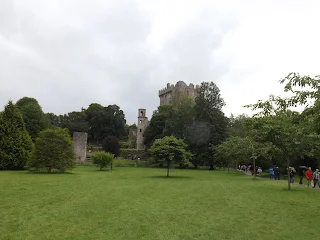No trip to Ireland would be complete if you did not visit the famous, or perhaps infamous, Castle Blarney just a short 5 miles NW of Cork City along route N20. The village of Blarney, where the castle gets its name, is a picture perfect setting with quaint shops, a few tasty pubs, and a large grass square in the center of the village. This town of nearly 2500 people who are what make Ireland so great for the tourist and that is their friendliness. J and L were never more thrilled than meeting and talking with the locals as we were on the trip to Ireland - as related in an earlier article - the people are so very genuine with their kindness it really makes one stop and think. Are people actually that kind and respectful?
The simple truth is that they are.
Now, back to the story of the blarney, which this writer knows something about with the tall tales he has written and will continue to write.
The Blarney Stone is the supposed
magical stone given to Cormac McCarthy (the original builder of the stone castle which had once been a simple wooden fortress) by Robert the Bruce in 1314. The stone, which was known as the Stone of Scone, was the same stone that Scottish kings were crowned over until that same Robert the Bruce took it away and brought it to Ireland. As a reward for his support during the Battle of Bannockburn, McCarthy received the stone from Robert the Bruce and had it placed into the wall of his stone and rock castle.
To kiss the Blarney Stone is said to give the
kisser the gift of eloquence. It came from a statement that Queen Elizabeth I made after getting frustrated with the Lord of Blarney (Cormac McCarthy) who always stated he would be loyal to the Queen of England but never was. He would
sweet talk her into thinking he was on the verge of giving in to her demands but could never quite find it in his soul to do so. Finally, after months and months of McCarthy's brand of diplomacy the Queen simply pouted and stated it was nothing more than a "lot of Blarney."
And the thus the legend was born.
The Blarney Castle Estate is a marvelous stop on any whirlwind adventure but if a person has the time, as we did, it takes hours and hours to saunter, study and enjoy the various locations about the estate. Particular attention needs to taken with the Rock Close where it said Druids and witches performed their
secret rituals. Then take the woodland walk to stare in wonder at the wonderfully old and so very green trees near the estate's lake, smell the various flowers in the arboretum or simply stroll the many gardens enjoying the beauty.

There is a small and neat
poison garden that was very interesting as the plants there could easily kill or cripple a person within seconds. Some of the names are familiar with those Harry Potter fans made famous by J.K. Rowling. Dangerous plants such as wormwood, hemlock, mandrake, deadly nightshade, wolfsbane, and of course, diviner's sage.
And, naturally, there is the castle itself. A rock solid (literally) edifice situated on a high rock outcropping which made it almost impenetrable to enemies. Of course, that was before the Irish-hating Oliver Cromwell, showed up and blasted the castle into near ruins with heavy cannon fire in the 17th century. There is plenty to see though as you climb up very narrow and steep stairs along the interior of the castle walls to the very top where the Blarney Stone is laid in among the rock structure. The view is terrific of the nearby countryside with forests and small villages from every side of the castle.
But to kiss the Blarney Stone is why we climbed those slippery stairs (it had rained a few moments earlier as we entered the castle and not having a roof everything was wet) and as luck would have it (actually J of J and L planned it like that) we were the first kissers of the day. There were two assistants standing by to help in the lying down and leaning into the air a hundred or more feet above the ground to kiss the stone. Of course, you have to lie on your back, lean way out in the air while holding two thin straps of iron and then lean further back while the two assistants encourage the kisser.
"There you go - a little further out into space - no, a bit further - don't look down - a little further - there you are and now kiss the stone."
As you arch back further than you believed your body could arch, you do of course look down upon a straight steep angle of the castle. As your mind races, it briefly crosses your mind that hopefully, if you did fall one of the jutting rocks of the wall may help in breaking the slip or kill you instantly thus saving you from being crushed to death by your own body weight while slamming into the ground.
.jpg)
Purse your lips and give the stone a kiss.
We did it and were done.
The gift of eloquence? Who knows, but no trip to Ireland is worth it without stopping by the Blarney Castle to pucker up.
And that is no blarney.















.jpg)
.jpg)